CSE 5280 Viewing Math Fundamentals



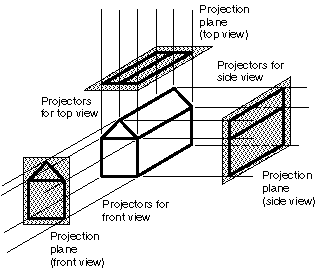
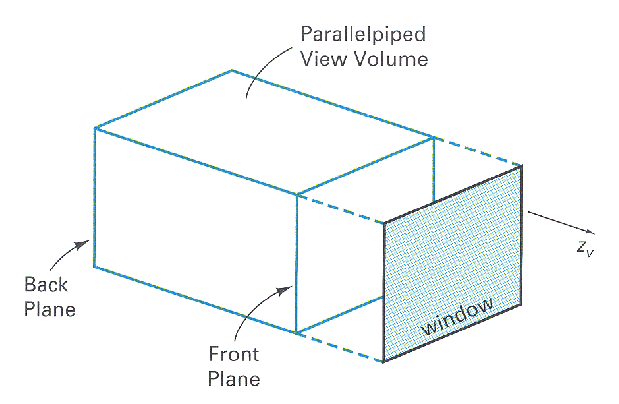
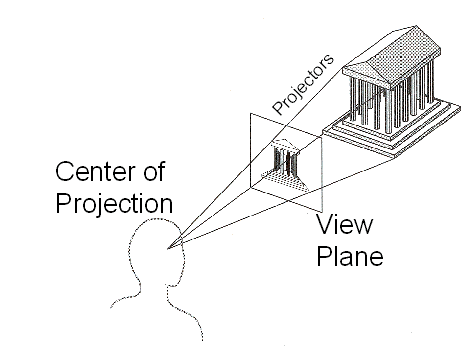

To simplify the math required for perspective projections, by placing the camera or eye in an axis-aligned configuration.
Put the focal point at the origin and the view (projection) plane parallel to the XY-Plane at a distance D (focal
length) from the origin.
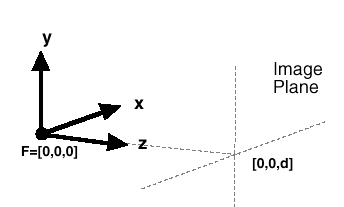
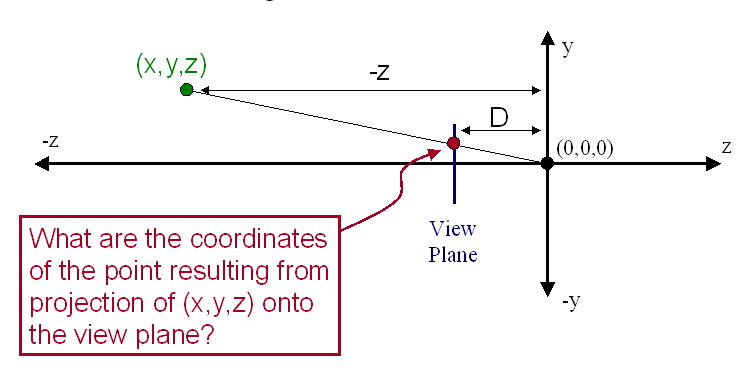
To determine the projection of (x, y, z) onto the view (projection) plane at z = D, we use similar triangles
to define the following ratios
xp / D = x / z; yp / D = y / z
xp / D * D = x / z * D ==> xp = x * D / z ,
yp / D * D = y / z * D ==> yp = y * D/z
Note how point (x, y, z) is projected to the view plane, to point ( xD/z, yD/z, D ). In this picture we are looking down the x-axis. We get something similar if we were looking down the y-axis. All values of z are allowed with the exception of z = 0. Points may be behind the center of projection as illustrated below.
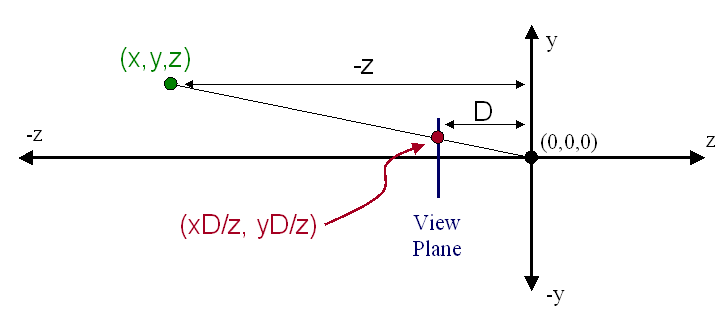
Note that we can increase the perspective effect by decreasing D (moving closer). We can represent this in matrix
form by using homogeneuos coordinates as follows:
[xh yh zh w] = [x y z 1] | 1 0 0 0 |
|0 1 0 0 |
|0 0 0 1/d |
|0 0 0 1 |
Look at example of a 3D line in object space from:
P1 (x1 = 2.0, y1 = 5.0, z1 = 6.0) to P2 (x2 = 8.0, y2 = 7.0, z2 = 12.0)
In parametric form this line is represented as:
x(t) = 2 + 6 × t ==> x(t) = x1 + t(x2 - x1)
y(t) = 5 + 2 × t ==> y(t) = y1 + t(y2 - y1)
z(t) = 6 + 6 × t ==> z(t) = z1 + t(z2 - z1)
Let us choose an arbitrary value of t (t = 0.4) and compute the x, y, z values)
x = 2 + 6 × 0.4 = 4.4
y = 5 + 2 × 0.4 = 5.8 so Pi(t = 0.4) = (4.4, 5.8, 8.4)
z = 6 + 6 × 0.4 = 8.4
Now perform the perspective transformation (assume d = 10.0) for P1, Pi, P2. Then we get for the transformed points:
P1(x = 1.25, y = 3.125, z = 6); Pi(x = 2.39, y = 3.15, z = 8.4);
P2(x = 3.64, y = 3.18, z = 12)
If this is still a straight line then all three coordinates of point Pi must have the same value of the parameter
t.
so for x we get 2.39 = 1.25 + t × (2.39) =>t = 0.48
for y we get 3.15 = 3.12 + t × (0.57) => t = 0.48
for z we get t = 0.40 since unchanged => therefore the points are not collinear.
To maintain linearity we can do a perspective depth transformation:
Zp = Z / (D + Z)
Then for point 1 Zp = 6 / (10+6) = .375
point 2 Zp = 12 / (10+12) = .545
point i Zp = 8.4 / (10+8.4) = .457
Now check with t value for point i 0.457 = 0.375 + t * (0.170) = .48. This is the same t value we got for point
i x and y. Therefore points 1, 2, and i are still colinear after the perspective depth transformation.. Note that
the relative z depth values remain unchanged, i.e. if Z1 < Z2 then Z1 / (Z1+d) < Z2 / (Z2+d) as shown below:
Z1 < Z2
Z1 × d < Z2 × d multiply both sides by d
(Z1 × Z2 + Z1 × d) < (Z1 × Z2 + Z2 × d) add Z1 × Z2 to both sides
Z1 × (Z2 + d) < Z2 × (Z1 + d)
Z1 / (Z1 + d) < Z2 / (Z2 + d)
Note that for Zp = Z / (Z+d) => 0 if d >> Z and => 1.0 if Z >> d
therefore 0.0 <= Zp <= 1.0
So to maintain linearity (or planarity) we must transform Z as well as X and Y.